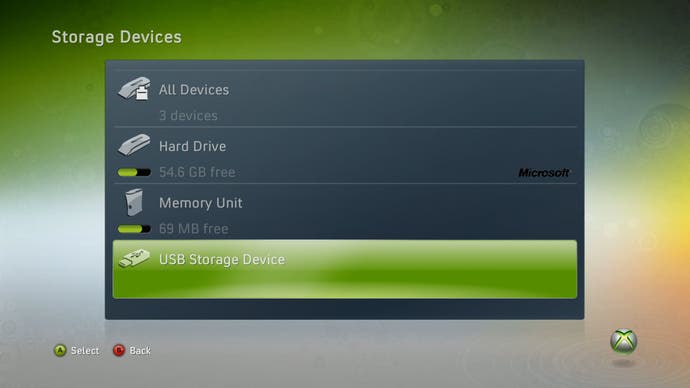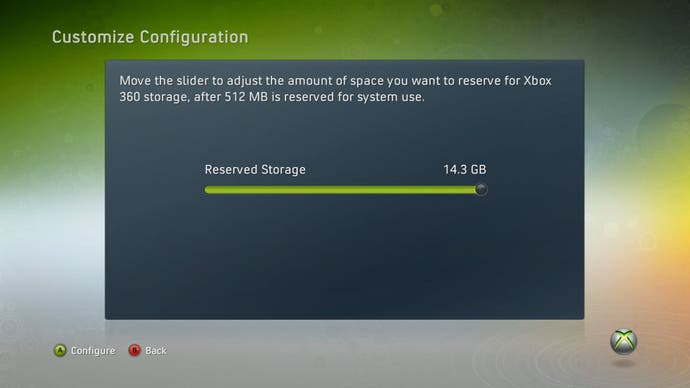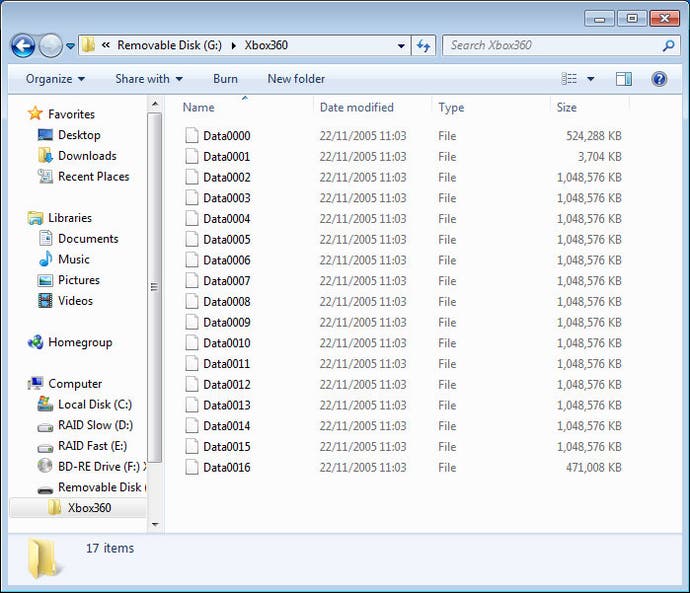Xbox 360 Storage Showdown: The Flash Factor
USB is the new HDD in Microsoft's latest dash upgrade.
This week's system update for the Xbox 360 saw the addition of support for USB drives on the console, allowing players - for the first time, officially - to use their own flash devices for extra storage. The age of the official Microsoft "MU" is finally over. With the new update, virtually any reasonably sized device can be used for all storage functionality the 360 offers.
Some say that it's too little, too late, citing the fact that there is a hard-set 16GB limit on device support, meaning that even if you buy a 500GB external drive, you can still only use a fraction of it. Others reckon it's a cunning scheme to circumvent a lawsuit from unofficial peripheral maker Datel, which used to offer its own MicroSD based solution before injunction-wielding heavies waded in. However, looking at it from a wholly positive perspective, the new upgrade offers a number of compelling advantages: you can carry around your profile, save games, DLC and even game installs on a key-sized drive.
Even more impressively, you can bag yourself more storage space, faster access speeds and swifter loading times for your Xbox 360 Core or Arcade than the original 20GB HDD bundled with the launch 360 deluxe packs. And you can do it for just £25, possibly cheaper. In this feature we'll show you how.
While we hesitate to mention it, we've also had a few emails suggesting that the new update, once transferred onto a CD or flash drive, also restores the "install to hard disk" functionality removed from Xbox 360s banned from Live at the tail-end of last year. Quite why Microsoft has chosen to do this remains unknown, but once again it may tie into the Datel lawsuit.
It's interesting to note that the USB storage option appears to have no limitations whatsoever. Any kind of USB mass storage device can be attached. We were even able to connect cameras directly to the Xbox 360, format their internal SD cards and then use them to install Halo 3. This isn't exactly recommended (at all), but it does serve to illustrate that the implementation in terms of device accessibility hasn't been deliberately nerfed: so long as the device exceeds Microsoft's own (extremely low) performance test threshold, it's show time.
So how does it work? It's simple. Just plug in your USB flash device, go to the memory area of the dashboard, and from there you can either set-up the drive automatically or else configure how much space you'd like to make available to the Xbox 360. A minimum of 512MB is reserved for "system operations": this cuts heavily into 2GB and 4GB flash drives in particular. However, in the preferred 16GB device configuration, you're still left with 14.4GB of actual, usable space - that's clearly a step-up from the 12GB found on the original "20GB" 360 HDD. Curiously though, if you use a drive larger than 16GB, the 360 gives you the option of allocating the entire 16GB onto the drive: it just hoovers up its 512MB overhead from the remaining space.


How the Xbox 360 allocates space on the drive is actually rather clever. There's no custom partition being created here: the 360 will format the drive when you set it up, but it's in the traditional FAT32 config common to most flash drives. From there, the console creates and populates a number of hidden files on the device.
Plug the drive back into your computer and you'll see it's still recognised as a standard USB mass storage device, albeit with reduced storage. If there's space left over, you can continue to use it for your own files. Configure your PC to view hidden files, and you'll see the 360's file allocation right there and then. A different amount of files are set up depending on how much space you have allocated, or the size of the flash drive itself.


The scope for backing Flash drive content is basically extremely limited. We moved across a folder of files from one drive to another, and the data was completely ignored: the 360 simply treated the device as though it was completely empty. However, the files can be backed up on your PC, and then copied back onto the same flash drive. A backup option limited to the exact same device from which the data came from is clearly limited, and the way that 360 files are embedded into the "Data" chunks means that you can't back-up individual items in the way you can on PS3.
Overall then, the implementation Microsoft has chosen is fairly neat, efficient and clearly scalable, albeit a touch stunted in some areas. Backup options are limited and there's a 16GB limit on the size of the partition the 360 can address. There is nothing to stop the platform holder raising that in the future should it ever feel the need. With the 20GB and 60GB drives all but extinct and the 120GB model on the endangered list, you can't help but feel that Microsoft could afford to be more generous with the USB allocation. It would be nice if it happens, but somehow we doubt it's even on the to-do list at Seattle.
The question now concerns the fact that the new expansion is entirely USB-based with the bandwidth implications that suggests. The direct SATA connection between the 360 HDD and its motherboard offers an enormous bandwidth advantage over USB: roughly 300 megabytes per second (MB/s) compared a theoretical maximum of 60MB/s (halve that for a more realistic estimate). How can it compete? Let's start rolling out some benchmarks.
The objective here was to sample a range of compatible USB devices and to see what kind of performance we could get. We were interested in how much of a throughput deficit there would be up against the SATA interface of the Xbox 360 HDD, and whether the flash storage option was actually competitive. The results were hugely revealing.
So, in terms of devices tested, we wanted a decent cross-section. To see the interface tested to its limits, we hooked up a full-on SSD via USB enclosure to effectively remove the bandwidth and access time limitations of the storage device. In addition to that, we used a range of USB flash drives, including a 4GB Sandisk Cruzer Blade, the Sandisk 2GB stick included in the Forza 3 Special Edition, and a specifically chosen 16GB ByteStor Dataferry drive bought from Amazon (more on that choice later). On top of that, we also added the laptop drive we removed from a 40GB PlayStation 3 and mounted it in another USB to SATA enclosure. For comedy value, we also added in a generic 8GB MicroSD card with adaptor, designed for use with mobile phones, where bandwidth and speed aren't exactly prime requisites.

